Completed Q1 2017 Floors 4 Owner Apple | Status Under construction Opened April 2017 Groundbreaking November 2013 | |
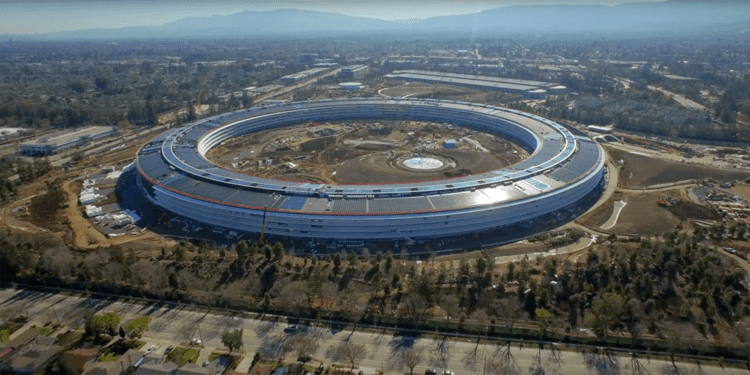 | ||
Address 19111 Pruneridge AvenueCupertino, CA 95014 Similar Apple Campus, Vallco Shopping Mall, Pandora – The World of Avatar | ||
Apple park the new campus in cupertino california
Apple Park (styled as Park) is the future headquarters of Apple Inc. in Cupertino, California. It is under construction and is expected to be completed by the end of Q1 2017, and start to be occupied in early 2017.
Contents
- Apple park the new campus in cupertino california
- Apple campus 2 apple park march 2017 update 4k
- History
- Design
- Costs
- Location
- Cafe
- Auditorium
- Wellness center
- RD facility
- Transit center
- Parking
- Visitor center
- Landscaping
- Inner courtyard
- Energy supply
- References
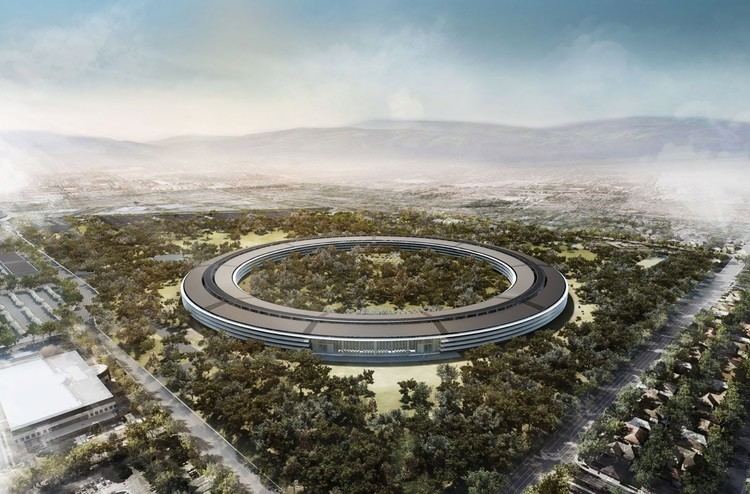
It is circular in shape, resembling the classic idea of a flying saucer spaceship that has just landed. It is located on suburban site now totaling 175 acres (71 hectares) and is planned to house more than 12,000 employees in one central four-storied circular building of approximately 2,800,000 square feet (260,000 square meters). Steve Jobs wanted the whole campus to look less like an office park and more like a nature refuge. Eighty percent of the site will be green space planted with trees and plants indigenous to the Cupertino area.
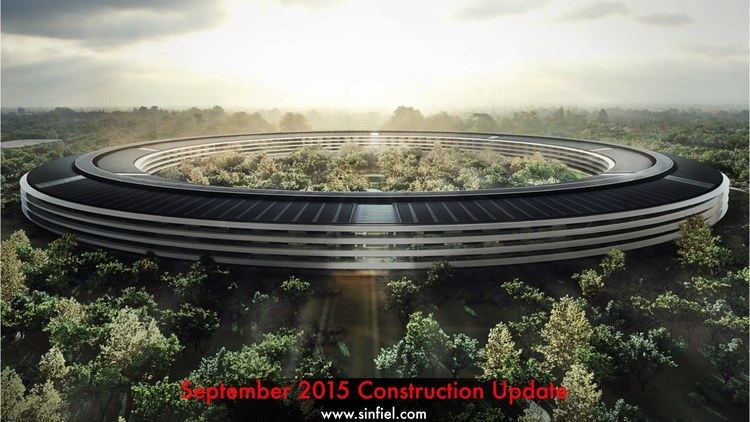
Apple campus 2 apple park march 2017 update 4k
History
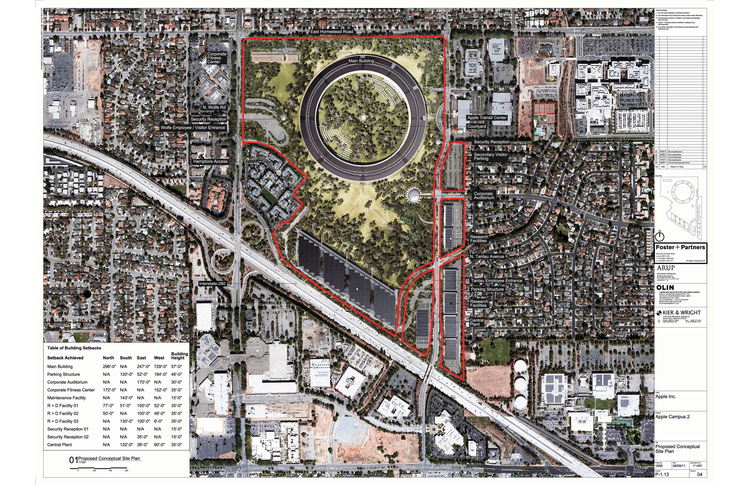
The building is a brainchild of late CEO, Steve Jobs, and designed by Lord Norman Foster. It all started when Steve Jobs called Norman Foster saying, "Norman, I need some help" and three weeks later they met in Cupertino. He asked Foster to consider him as team member rather than a client. He took the architect to the cathedral-like building on the Pixar campus in Emeryville, which Jobs designed himself with the goal of keeping everyone and everything under one roof. Steve Jobs spent a large part of two years on the project before his death in 2011.

In April 2006, Steve Jobs announced to the city council of Cupertino that Apple had acquired nine contiguous properties to build a second campus, the Apple Campus 2.
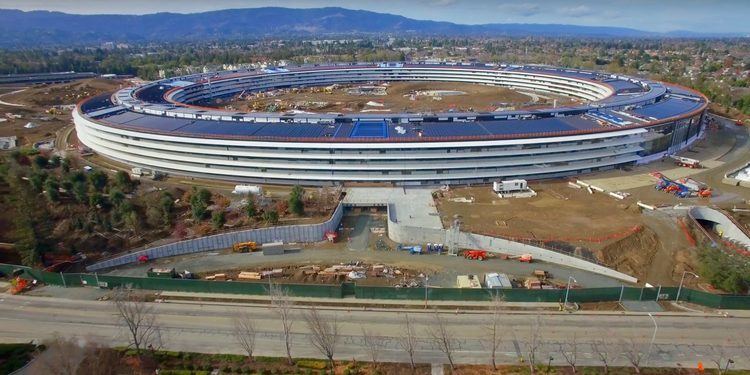
Purchases of the needed properties were made through the company Hines Interests, which in at least some cases did not disclose the fact that Apple was the ultimate buyer; Philip Mahoney, a partner with a local commercial real estate brokerage, noted that this is common practice in attempts to arrange the purchase of contiguous land made up of multiple parcels with separate owners, in order to keep costs from skyrocketing and not reveal the company's plans to competitors. Among the sellers of the properties were SummerHill Homes (a plot of 8 acres or 3.2 hectares) and Hewlett-Packard (three buildings of their campus in Cupertino), among others.
Until April 2008, Apple had not sought the necessary permits to begin construction, so it was estimated that the project would not be ready in 2010 as originally proposed; however, the buildings on the site are being currently held by Apple for its operations. In November 2010 the San Jose Mercury News revealed that Apple had bought an additional 98 acres (40 ha) no longer used by HP Inc., just north across Pruneridge Ave. This space used to be the HP campus in Cupertino before it was relocated to Palo Alto.
On June 7, 2011, Apple's then-CEO Steve Jobs presented to Cupertino City Council details of the architectural design of the new buildings and their environs.
On October 15, 2013, Cupertino City Council unanimously approved Apple's plans for the new campus after a six-hour debate. Shortly thereafter, demolition work began to prepare the site for construction.
Originally expected to break ground in 2013 and open in 2015, the project experienced delays and started in 2014. It is expected to open in April 2017, according to an Apple press release on February 22, 2017.
On February 22, 2017 Apple announced the official name of the campus to be "Apple Park", and the auditorium to be named "Steve Jobs Theater".
Design
Steve Jobs was quoted as saying: "It's got a gorgeous courtyard in the middle, and a lot more. It's a circle, so it's curved all the way round. This is not the cheapest way to build something. Every pane of glass in the main building will be curved. We have a shot, at building the best office building in the world. I really do think that architecture students will come here to see it." This proved to be Jobs' last public appearance before his death in October 2011.
The ring-shaped building, advertised as "a perfect circle," was not originally planned as such. The inner rim and outer rim on each floor will be left open as walkways. There are 8 buildings, separated by 9 mini-atria. The campus is one mile in circumference, with a diameter of 1,512 feet (461 meters). The one circular building will house all employees. It is four stories above the ground and three stories underground. Apple created life-size mock-ups of all parts of building to iron out any design issues.
The inner part of the circular building will be a 30-acre (12 ha) park, with fruit trees and winding pathways, inspired by fruit orchards of California. A pond is also part of it.
The design hides the roads and parking spots underground. The campus uses only glass for its walls and views of the inner courtyard or to the landscape facing the exterior of the building. The campus is designed with winding paths that traverse the campus, with verdant surroundings, with open seating areas for employees to meet. Around 83,000 sq ft (7,700 m2) of space is for meetings and breakout spaces in the building.
Steve Jobs wanted no seam, gap, or paintbrush stroke visible for a clean fit and finish. He was inspired by the main quad on Stanford University.
All interior wood to be used for furniture was to be harvested from a certain species of maple. Apple is working with construction companies from 19 countries for design and material supply.
A breathing, hollow concrete slab will act as the building's floors, ceilings, and HVAC system. A total of 4,300 such slabs will be used for building. Some of the slabs weigh 60,000 pounds (27,000 kilograms).
The building core and shell were built by DPR/Skanska, while Rudolph & Sletten and Holder Construction worked to complete the interior fit-out.
Costs
The land cost was estimated at $160 million. The project cost initially was estimated at $500 million. However, in 2013 the total cost was estimated to be nearer to $5 billion.
Location
Apple has had a presence in Cupertino since 1977, which is why the company decided to build in the area rather than move to a cheaper, distant location. Campus 2 is located one mile east of the existing facility. The campus is also next to a contaminated site under Superfund legislation with a groundwater plume.
Cafe
The campus will have seven cafes, and the largest three-level café is for 3,000 sitting people, it has light-colored stone lining and glass railing with no metal support. It is surrounded by extensive landscaping. The mezzanine space of 20,000 sq ft (1,900 m2) can accommodate 600 people and 1,750 seats on terraces outside, with a capacity to serve 15,000 lunches a day, housed by specially designed 500 tables made of solid spesshart white oak, measuring 18 ft (5.5 m) long and 4 ft (1.2 m) wide.
The sports tables and benches resemble those in Apple Stores. The large doors of the main restaurant are 92 ft (28 m) tall, the biggest in the world. The cafe extends to grassy landscape well beyond the glass walls and will be able to dine al fresco in an area Apple’s calling the glade.
Auditorium
To be named as Steve Jobs Theater after the co-founder of Apple, located atop a hill on the campus the underground, 1000 seat auditorium for Apple product launches and press meets is also being built. A large cylinder shaped lobby with stairs down to the auditorium. The theater, as referred by Apple, will have 350 parking spots on North Tantau and a pedestrian path leading to the main campus located Northwest of the theater. This will provide Apple with more control over product releases and unveiling.
The unique and outstanding theater will be all cylindrical glass walls, column-free and roofed with carbon fiber. This helps in an unhindered, 360-degree view of the verdant campus. The carbon fiber roof, one of the strongest and lightest material known to man, will be entirely supported by the glass walls. The 80-short-ton (73-metric-ton) carbon fiber roof, made of 44 identical panels was supplied by a Dubai-based company, Premier Composite Technologies. Each panel is 70 ft (21 m) long and 11 ft (3.4 m) wide and locks in the middle with the other panels.
Wellness center
A 100,000 square feet wellness/fitness center is located in the northwest of the campus. It can serve up to 20,000 employees around Cupertino. Apart from gym equipment, the fitness center will feature other amenities like changing rooms, showers, laundry services, and rooms for group sessions.
R&D facility
Two large buildings 300,000 square feet (28,000 m2) on the southern edge of the campus are being built, isolated from prying eyes. The top floor will house the R&D department comprising industrial design and human interface teams headed by design chief, Jonathan Ive.
Transit center
Employees traveling to Apple by bus will board and depart from the subterranean bus station, which leads to the main campus via two white staircases. The bus fleet will increase by 20%.
Parking
Parking is built both underground and in two large parking structures accommodating approximately 14,200 employees. There will be 300 car charging stations on-site.
There will be 2,000 parking spaces in the subterranean parking garage. The parking will be managed by sensors and apps, which will manage the traffic and parking spaces.
Visitor center
The North Tantau Avenue Visitor Center is a two-story 20,135 sq ft (1,870.6 m2) structure which features a 2,386 sq ft (221.7 m2) café and observation deck overlooking the campus and a Apple Store. The estimated cost of the center is $80M. The property at 10700 N. Tantau (NE corner of Tantau and Pruneridge) is across the road from the campus proper and abuts a Santa Clara residential neighborhood. The underground parking garage, with close to 700 spaces, has an estimated cost of $26M.
There will be 1,000 bikes on the campus for employees to get around, with miles of cycling and jogging trails all over the 175-acre (71 ha) campus.
Landscaping
Currently, only 20% of the campus is green space; when Apple is done with construction, it will consist of 80% green space. The big courtyard in the middle of the main building will be verdant with apricot, olive, and apple orchards and a herb garden near the cafe. The plants selected for the campus landscape are drought tolerant. Recycled water will be used to water the campus.
Apple hired a leading arborist, Dave Muffly, from Stanford University to cultivate California's natural environment around the campus. There will be 9,000 trees on the campus, of 309 varieties of indigenous species. The trees that will be planted are Oak savanna, Oak wood, and fruit trees including apricot, apple, plum, cherry and persimmon. An additional 15 acres (6 ha) are planned to be used for a native California grassland. Of the 4,506 trees on former campus, 1,000 will be replanted on the new campus. Their arborist has been growing more than 4,600 trees in various nurseries for their eventual transplant to the campus. It will include both young and mature trees, and native and drought tolerant plants that will thrive in Santa Clara County with minimal water consumption.
The trees on the perimeter will be retained and more will be moved to the perimeter, to act as a natural fence.
Inner courtyard
The inner courtyard is 30 acres (12 ha), and covered in fruit trees with a pond.
Energy supply
The site will be powered by 100% renewable energy, making it one of the most energy efficient buildings in the world. The solar panels installed on the roof of the campus can generate 16 megawatts of power, sufficient to power 75% during peak daytime. The other 4 megawatts will be generated onsite using Bloom Energy Server fuel cells, which are powered by biofuel or natural gas. The air will flow freely between the inside and outside of the building, providing natural ventilation and obviating the need for HVAC systems during nine months of the year.
